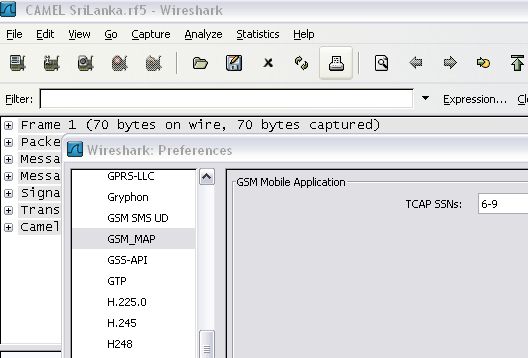Thanks for your help
!
< These ares my questions on the whireshark
:
<
< - is there any possibility to know on which ITU, ETSI,
3GPP
< recommandations releases have been coded the dissectors to be used
for
< MAP, CAMEL, ISUP, BSSMAP, RANAP, etc.. Application Parts
?
> For the most part, the versions used by the dissectors are listed
in the header of each source file.
> For example, you can read at the top
of the GSM-MAP dissector:
> http://anonsvn.wireshark.org/viewvc/viewvc.py/trunk/epan/dissectors/packet-gsm_map.c?view=markup
> * References GSM MAP:
> * ETSI TS 129
002
> * Updated to ETSI TS 129 002 V7.5.0 (3GPP TS 29.002 V7.5.0
(2006-09)
> Release 7)
> * Updated to ETSI TS 129 002 V8.1.0
(3GPP TS 29.002 V8.1.0 (2007-06)
> Release 8)
> * References
GSM SS
> * References: 3GPP TS 24.080
> For dissectors
generated from the ASN.1 source (such as GSM MAP) you can check the ASN source,
too:
OK, one suggestion could be
to access these release data informations from the WireShark
Preferences Window ! (see capture file below)

< - The K12
Tektronix analyzer give us the way to build ourself the
< protocol stack
corresponding to a specific GSM.xx or TS.xx
< recommandation release ! Is
it possible to add in your project a tool
< to manage these protocol
stacks, specialy because, for training and
< pedagogic objectives, it
should be nice to control exactly the output
< of a trace decoding
?
> I think the assumption has been that the protocols are backwards
compatible
> Interworking of GSM systems would be difficult otherwise I
suppose.
Well, all the protocols are not
systematically "backward compatible" ! the GSM system interworking is based on a
special feature introducing the "fall back" scenario : when two Network
Equipments do not support simultaneously the same MAP Application Context (AC)
release, then, according White Book TCAP capability, it becomes possible to
restart the dialogue using lower version of this AC !
The consequence is that
interworking control (specialy during test agreement phases for a new feature
between two Mobile Telecom Operators) needs to know on which AC version should
be handled this new feature ==> by the way starting SS7 exchange analysis
using the "best = max" MAP AC version available is not all the times efficient
!
> In case of GSM MAP the dissector automatically
handles differences in the versions
> For CAMEL there is an open BUG about
one problem but it looks solvable without
> introducing a version
option.
> For the other dissectors there has been no bug reports on
version problems.
<PS: I know that some of wireshark users would like
to have some K12
<style traces (rf5 file type) ==< I can proposed some
examples on Mobile
<Telecom Network (DTAP, BSSMAP, ISUP, CAMEL, MAP)
issued fom different countries.
> New example traces to the wiki
samples page are always welcome.
See attached zip
file
Additional questions
:
- I don't succeed to build a
filter to isolate a complete TCAP transaction based on "Original transcation id"
and "Destination transaction id" parameters ==> very, very, very helpfull to
retrieve among several records one GSM MAP procedure (i.e. a complete "Update
Location" with its "Insert Subscriber Data" messages)
+ the same
request for a SCCP connected oriented procedure base on "SCFid" (i.e. to follow
a complete BSSMAP call establishment from the Connection Request to the
Connection Release) : is it possible ? or do we have to imagine a macro
mechanism ? like ==>
- Is it possible to build a kind
of "filter macro script " where wireshark could pause its process, asking to the
user one reference, and resuming its filter action by using the user response in
the filtering macro ?
Best regards
Alain.
Attachment:
from K12.zip
Description: from K12.zip
